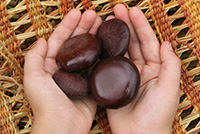
the first indigenous games trail in Queensland
On Sunday May the Gold Coast City Council celebrated the opening of the Kaialgumm Games Trail at the Gold Coast Regional Botanic Gardens. This is the first of a series of indigenous games trails to be located in parks and gardens throughout the state.
Designed and developed as an Embracing 2018 initiative for the Commonwealth Games, the Kaialgumm Games Trail was delivered in conjunction with Nature Play QLD.
All the traditional ‘Aboriginal and Torres Strait Islander’ games were sourced from Australian Sports Commission publication, Yulunga – Traditional Indigenous Games and used with the permission of the Australian Sports Commission.
The Australian Sport Commission and the Queensland Government acknowledges Ken Edwards for his extensive and thorough research in collating the source material for Yulunga: Traditional Indigenous Games.
Most of these games were played to help children learn skills they needed later in adult life, for hunting and fighting. The word kaialgumm comes from the local Yugambeh language of the Gold Coast. The kaialgumm was traditionally the chief in hunting.

To access information about each of the games as they progress along the trail, visitors need to scan a QR Code* at each game location using a QR Code reader on their mobile devices.
For example, this QR code brings up the Gold Coast City Council Kaialgumm Games Trail web page

There are several QR code reader apps available such as Scan which you can find here: Apps for Outdoors, Utilities
Sample Games that can be played on the Trail
Background
This game comes from North Queensland and was used to practice throwing skills. Traditionally a large animal bone with twine attached to it was thrown over an emu catching net and into a pit. The skill was to get the bone into the pit without touching the net.

Kee’an means to play in the Wik-Mungkan language of North Queensland.
How to play
Number of players: up to eight (8) players, singly or in teams of two (2.)
Equipment: foxtail or comet balls or a tennis ball in a long sock, a net, e.g. volleyball or badminton net and a plastic bin, bucket or plant pot for hole.
Visit the Botanic Gardens Friends Centre if you would like to borrow the equipment to play this game.
More information
Variation: increase the throwing distance as players’ skills improve.
Background
This throwing game was played on Mer Island in the Torres Strait in the 1900s. The game is named after the beans of the kolap plant, which were used as throwing objects. The kolap plant is also known as the matchbox bean, or Entada phaseoloides. It is a large vine that grows in coastal rainforests in North East Queensland, and produces hard, 5-6 cm wide seeds. The distinctive, hard seeds have been used as beads, toys, and for making match boxes and snuff boxes.
How to play
Number of players: 2 to 4 players in two teams.
Equipment: Two small mats/towels, 4 to 8 small flattish objects suitable for throwing, e.g. beanbags, coins or small stones.
You may also find fallen fruits or seeds from nearby trees that you can use (but please don’t pick fruit from the trees).
Visit the Botanic Gardens Friends Centre if you would like to borrow the equipment to play this game.
- Two players stand 2 to 3 metres behind each mat.
- Each player has four (4) kolaps and teams take their turn to try and throw these onto the mat in front of them.
- Kolaps must land completely on the mat to count as one point.
- The team that reaches the combined score of 20 first wins.
QORF and Nature Play QLD will feature each of the new trails when they open to the public.
Meanwhile get along to the Kaialgumm Games Trail.
Gold Coast Regional Botanic Gardens
230 Ashmore Road, Benowa
Find on Google Maps
*What is a QR Code?
QR is short for Quick Response (they can be read quickly by a cell phone). The code is a machine-readable array of black and white squares, typically used for storing URLs or other information for reading by the camera on a smartphone. They are used to take a piece of information from a transitory media (poster, business card, magazine …) and put it in to your cell phone. It might take you to a web address, add a contact to your address book, prompt you to make a call, ask you to book a ticket … and more.
Have a story to tell or news to share
Let us know by submitting a news story, an article, a review, a white paper and more …
Submit


